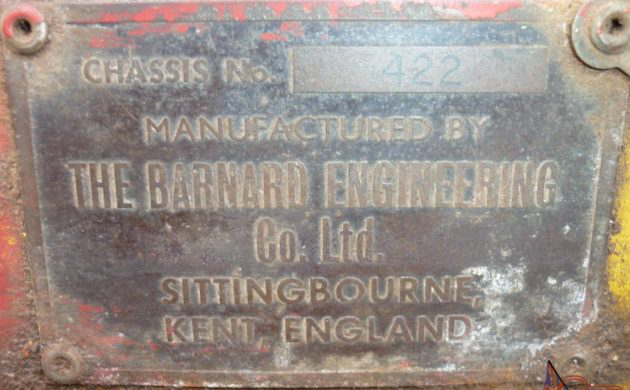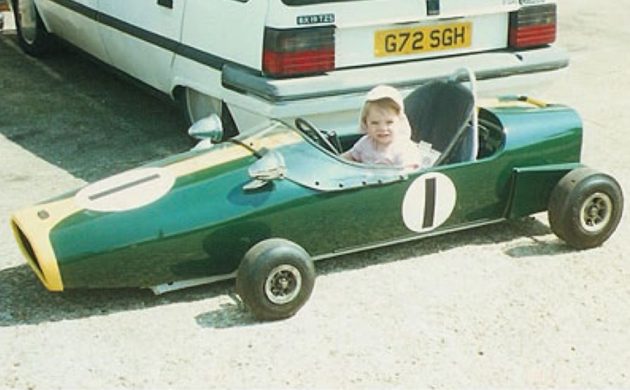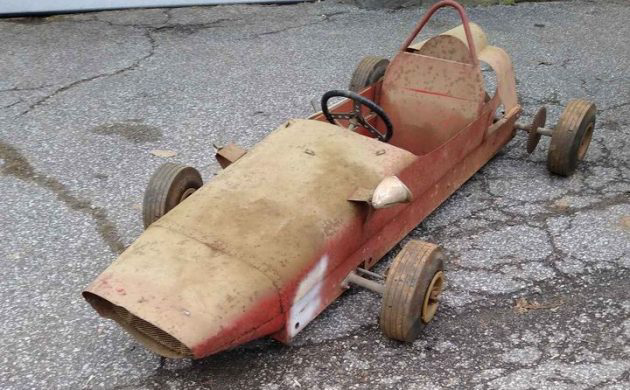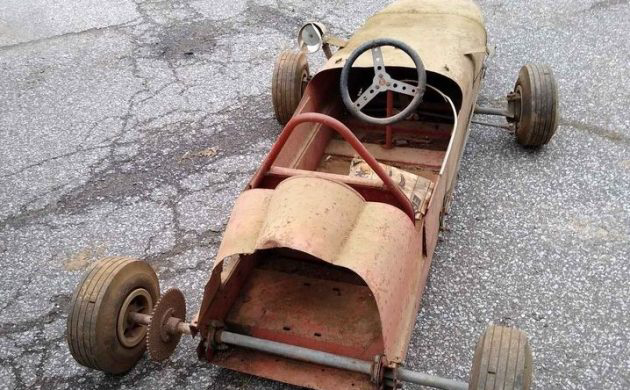Usually, when one thinks of go-karts, memories drift back to the steel, open frame kart we had as kids, usually one with a motor appropriated from dad’s lawnmower. As to the origin of karting, that’s speculative though one source assigns it to Art Ingels who built the first cart in 1956 and then organized a race in the Rose Bowl parking lot in Pasadena, California. Is this the true commencement? Hard to say with any accuracy. There was a British company, however, Barnard Engineering that got in on the act in the 1960s, and today, we’re going to review one of their products in the form of a 1967 Formula 6 kart. It is located in Charleston, West Virginia and is available, here on Facebook Marketplace for an unknown price. Thanks to Chuck F. for this tip!

The history around Barnard Engineering Company LTD is sparse. They were located in Sittingbourne, Kent, U.K. and there is an automotive engineering company there today, by the name of B.D. Engineering LTD., but they are a car tuner operation and probably not of a successive relationship. From Bodyline, I found this bit about the Formula 6, “The Barnard Formula Six was built in 1967 in Sittingbourne, Kent. It has a sheet steel chassis and fiberglass body. The engines varied in size from 75cc to 170cc, lawnmower derived. They were first launched at the racing car show at Olympia, but were unfortunately not a success as they were too expensive for the market at which they were aimed.”

This subject kart, unlike the restored example above, doesn’t appear to have any fiberglass bodywork, as it would seem to be all steel and unadorned other than one of its original racing mirrors, the steering wheel, and the brake lever. The steel construction looks to be sound however, it seems as if it is just waiting for the return of its long-departed engine. The engine’s four mounting holes are clearly visible and look to be of a flange pattern used by a horizontal shaft Briggs and Stratton motor or another similar, single-cylinder engine. The chain sprocket, still attached to the rear axle, is clearly visible.
While rare, it’s difficult to say if it’s valuable. The seller’s price of $123,456 is not helpful and is clearly a placeholder, so the guess is that this is another Facebook Marketplace “make me an offer” arrangement. This Barnard Formula 6 could be fun, especially if dolled up like a Formula One racer, and assuming that one larger than a nine-year-old could fit, but then how much fun would be dependent on the price and powerplant selected. While the go-kart name Barnard is unknown to me, do any of you have familiarity with it?




Phwoar! Lovely BX…
What is that weird car behind the kid in the go-cart.
I think Derek answered your question…
Connecticut Mark…..
Who cares..
Connecticut Mark does , he is obviously a car guy since he’s on this site and would like to know . I’m not up on 1980s European cars, but it looks a bit like a Renault to me.
No need to be so nasty, Stu.
I would like to know what it is, as well.
Citroen BX
But it’s not all dolled up it’s just a starting point never the less it would have been a great father and son project
Here’s a fun one, to shift gears from Flintstone Nissans and such. While I’ve never seen this particular kart, in the 60’s, the British were very proud of the Lotus racing team. They literally cleaned up on the Offy’s at the time. The racing sounds went from the low growls of the Offy’s, to the whine of the Lotus. It was the end of an era for Offenhauser, which had dominated racing up until then. As a kid, we would make wooden push karts with that front end. Jim Clark was my boyhood hero, of sorts, and I made several models of the Lotus. I, along with many, was devastated when he was killed.
Normally, years ago, a motorized kart was the epitome of coolness for every kid, driving was paramount, and karting was a sneak preview of driving. I’m not sure that kind of enthusiasm exists today. Like I mentioned earlier, my nephew and his son, bought a side by side cheapie, on the maiden run, they got going way too fast, wiped out, and it’s been sitting ever since. Where to run it is another concern. I hope someone fixes it. We seem to have lost the definition of fun, and for us, this was it.
The weird car is a Citroën BX from mid 80s. Great cars, designed by Gandini. Cheaper than a Miura/ Countach.
I remember the Barnard racer. Built by a guy called Tom Barnard and called Formula 6 because he hoped to get a racing series for juniors recognised.
That didn!t happen and project died, but if price is not silly, this is worth restoring. Suspect body may be aluminium not steel as it was a serious project at the time (mid 1960s)
Ah yes, that typical British aluminum rust – we yanks had to make do with iron rust . . .
Doh! You win! Me has chingado…..
But the Brits do have a talent with rust…..
I’m at a loss as to how this was expected to stop! There is no evidence it ever had any brake equipment at all!
Maybe it’s really a baby Bugatti as ol’ man Bug reportedly said he made his cars to go, not stop!
Hi Bill, we went through a lot of P.F. Flyers trying to stop these things,,
Well Martin – good to see you are multi lingual. It’s a useful word, isn’t it.
1956 is hardly the beginning of carting. I built one in 1946, using the gasoline engine from an old washing machine – even had it’s own kick starter – and steering from a wagon. And my friends had similar machines. I imagine there were carts built even before that. Of course I was in Michigan, and God forbid anything automotive starts there rather than California.
The first go cart was the Auto Red Bug, back in the 20’s… Although most carts were without suspension and the Red Bug used the flexibility of the wood slats in its frame to give it some flex. If I recall, they used a single cylinder petrol engine with an “outrigger” propulsion system (direct drive to the pavement!)
I was both Go Cart and Mini-bike crazy when I was about 10 to 11 years of age. Lawn motor motors , held into position using a collection of angle iron and wood. Unsafe at any speed, for certain. “Brakes” on the Carts consisted of a “kill” switch, which cut the ignition. The engine compression alone was responsible for slowing down the beasts… Not particularly effective, to say the least. We eventually added a piece of wood that rubbed against the back tire (we must have gotten the idea for this from “our Gang” or Little Rascals”!)
The Mini bikes were somewhat more refined. They consisted of a cut down bicycle frame with some bolted together angle iron and a piece of 3/4″ plywood to hold the motor in place (sometimes!). The biggest engineering obstacle was that the lawn mower motor had to be tremendously offset to one side, so that the pully on the motor would align with the pully on the back wheel. The motor was almost completely to the left of center on the frame. These creations also featured a Kill Switch to cut the power, but NO Brakes!
We did have a way to stop… We wore heavy boots (they were called “engineers boots”) and stopped the bike by dragging our boot on the pavement,”Fred Flinstone” style! Please note that I said Boot, and not Boots as we were leaning over due to the motor bring so off center. At least we could JUMP OFF the bike before impact.
The carts were less safe, despite their 4 wheels. The bikes were driven with 30 degree lean, but at least you could BAIL (sometimes)
Its amazing that we survived childhood … Only one kid had broken bones: most of us escaped with scrapes and scratches.
I would have liked to write that the kid who got hurt became Evil Kineval… but that was not the case. He Became an ACCOUNTANT!
I remember my mother saying to me: “why can’t you boys just play baseball, like everyone else?”
Formula 6? Looks more like formula death!
Barnard Formula 6 racers were initially designed for kids from 10 to 17 years of age. There were single seaters and “D-type” sports cars, all powered by Briggs and Stratton 210cc 5hp engines.
Tom Barnard, the maker of this vehicle, is still alive and resides in Swanage, Dorset, UK.
https://www.transporterama.com/index.php?/reviews.html/reviews/bookreviews/tom-barnard-i-gathered-no-moss%C2%A0-r3/
they also had 3 h.p. engines…ive restored a number of them over the years